Ettrick Bay
Ettrick Bay is a wide, tidal, sandy coastal embayment with a chord of 1 mile (2 km), on a 218° bearing, located on the west coast of the Isle of Bute in the Firth of Clyde, within council area of Argyll and Bute in Scotland.[2] The bay was used for practice training for the D-Day landings.[3]
| Ettrick Bay | |
|---|---|
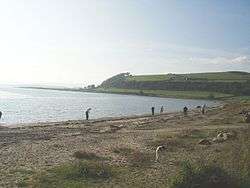 Ettrick Bay from the south, looking north as the bay curves to Kildavanan Point | |
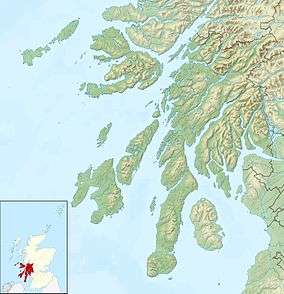 Ettrick Bay | |
| Location | Isle of Bute, Argyll and Bute Scotland |
| Coordinates | 55°50′39.592″N 5°8′33″W |
| River sources | Glenmore Burn Ettrick Burn Drumachloy Burn St Colmac Burn |
| Ocean/sea sources | Atlantic Ocean |
| Catchment area | 22.5 kilometres (14.0 mi)2[1] |
| Basin countries | Scotland |
| Max. length | 1.7 km (1.1 mi) |
| Max. width | 0.960 km (0.597 mi) |
| Average depth | 20 metres (66 ft) |
Geography
The bay faces the Kyles of Bute, a narrow sea channel that separates the northern end of the Isle of Bute from the Cowal peninsula, and offers views of Isle of Arran.[1] The bay is bounded by a coarse sandy beach which is popular with tourists and local people. During low tide, the water's edge can be up to 500 metres (1,600 ft) from the high tide mark.[1] A number of rivers flow into the bay, including the Glenmore Burn, Ettrick Burn, Drumachloy Burn and St Colmac Burn.
At the north end of the bay, which mainly consists of rocky outcrops, lies the Kildavanan Point, with the feature known as Macallister's Gun, located close to the point. At the south end of the bay is the rocky outcrop called Island McNeil, which forms the outer boundary of the bay.
The surrounding area is mostly rural with agriculture being the main land use. Average rainfall for the region is 392mm, compared to 331mm in Scotland as a whole.[1] Windy Hill is the highest peak on the Isle of Bute. Located directly to the north of the bay, it is 278 metres (912 ft). Other small hills surrounding the bay include:
- Eanan Hill to the north east – 166 metres (545 ft)
- Glenabea Hill, behind Eanan Hill – 201 metres (659 ft)
- Kilbride Hill, which bounds Windy Hill at the east side – 256 metres (840 ft)
- Muirton Hill, which is to the south of Windy Hill – also 256 metres (840 ft)
To the east and south of the bay, all the hills are shallow.
3.25 miles (5 km) miles directly south of Ettrick Bay lies the sheltered bay of St Ninian's Bay, which is named after the 8th-century Christian saint Saint Ninian. The island of Inchmarnock can be seen from Ettrick Bay and lies on a south by south west bearing of around 200° at a distance of 3.25 miles (5 km) from the bay, and is located at the northern end of the Sound of Bute in the Firth of Clyde on the same longitude as St Ninian's Bay.
Settlements
The nearest town to the bay is Rothesay, which is 2.5 miles (4 km) to the south west. The small coastal village of Port Bannatyne is located 2 miles (3 km) to the north east, on Ardbeg point of Kames Bay. Kames Castle and, 500 metres (1,600 ft) to the north, Wester Kames Castle stands near to Kames Bay.
Features
A Bronze Age stone circle is situated at St Colmac Farm, which is located south of the B875 road to Ettrick Bay from Port Bannatyne, about 0.6 miles (1 km) northeast of the shore of Ettrick Bay. A Celtic cross that is often associated with the stone circle is located at the ruined 19th-century church of St Colmac, about 100 metres (330 ft) from the stone circle in a north west direction. A well-known tourist attraction, and often associated together, they were built several thousand years apart.[3] At the bridge over Glenmore Burn lie concrete frames built for the British Army for exercises on Inchmarnock. These frames represented practice landing craft for D-Day landings.[3]
Gallery
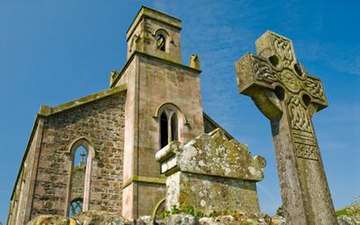 Abandoned St Colmac Church with ancient Celtic Cross
Abandoned St Colmac Church with ancient Celtic Cross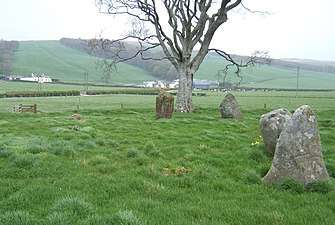 Stone Circle near St Colmac Farm
Stone Circle near St Colmac Farm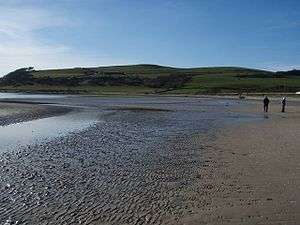 Ettrick Bay
Ettrick Bay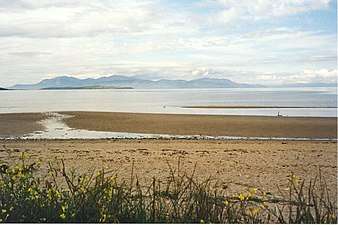 Ettrick Bay looking towards the Isle of Arran
Ettrick Bay looking towards the Isle of Arran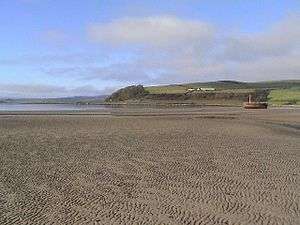 Looking towards the north and the point on the Kildavanan Point
Looking towards the north and the point on the Kildavanan Point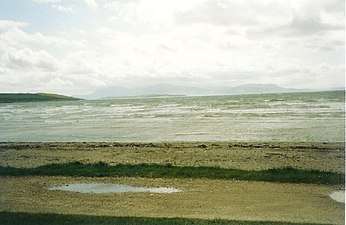 Looking south over a stormy Ettrick Bay. The island of Arran is visible in the distance
Looking south over a stormy Ettrick Bay. The island of Arran is visible in the distance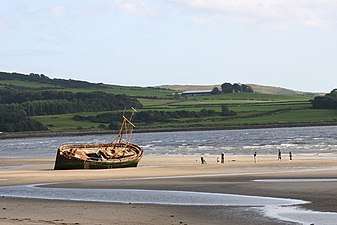 This view of Ettrick Bay beach, taken from the cafe car park, shows an abandoned and wrecked fishing boat
This view of Ettrick Bay beach, taken from the cafe car park, shows an abandoned and wrecked fishing boat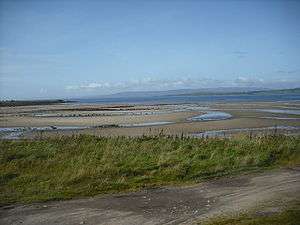 The beach from the car park looking south
The beach from the car park looking south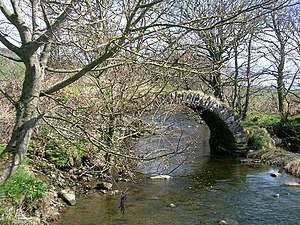 The ancient and ruined Drumachloy Bridge over the Drumachloy Burn
The ancient and ruined Drumachloy Bridge over the Drumachloy Burn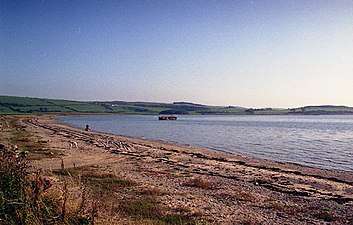 Ettrick Bay looking south
Ettrick Bay looking south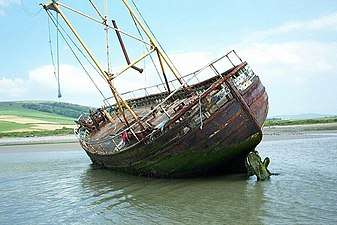 Fishing boat that was wrecked in 1994 and removed in 2007 when it became dangerous after a winter storm. The crew mistook low-lying ground for a channel to the north of the island and foundered[4]
Fishing boat that was wrecked in 1994 and removed in 2007 when it became dangerous after a winter storm. The crew mistook low-lying ground for a channel to the north of the island and foundered[4]
References
- "Bathing water profile:Ettrick Bay" (PDF). SEPA. Retrieved 30 April 2017.
- "Ettrick Bay". Gazetteer for Scotland. School of GeoSciences, University of Edinburgh and The Royal Scottish Geographical Society. Retrieved 20 April 2017.
- Hamish Haswell-Smith (2008). The Scottish Islands: The Bestselling Guide to Every Scottish Island. Canongate. p. 26. ISBN 978-1-84767-277-3.
- Elliott, Simpson. "Shipwreck at Ettrick Bay". Geograph® Britain and Ireland. Geograph Project Limited. Retrieved 2 May 2017.